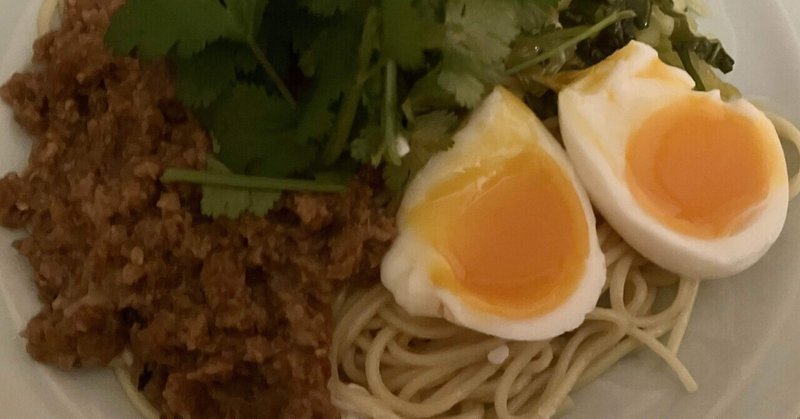
まぜそば(あえて乾麺使用) Mazesoba (Soupless noodles / dried noodles used)
「まぜそば」は「混ぜるそば」のことだ。日本語の「そば」は、日本特有の蕎麦粉を使った麺という意味以外にも「中華そば(麺)」の意味でも使われることがある。「中華そば」は鹹水の入った小麦粉麺で、第二次世界大戦で中国から帰ってきた帰国者や中国系移住者によって日本でもポピュラーになり、「ラーメン」と呼ばれてすっかり日本化しソウルフードとなった。ラーメンは、今では中国に逆輸出されたり、世界中に専門店ができたりして、すっかり人気者になっている。点心扱いの中国の麺料理とは違い、忙しい日本のビジネスマンが、これ一食でランチやディナーを済ませられるよう、主食級に格上げされた豪華な麺料理と言える。
The literal translation of "mazesoba" is "mixed soba". The Japanese word "soba" means noodles made from buckwheat flour, which is unique to Japan, but it can also mean "chinese noodles". "chinese noodles" are wheat noodles with salty water, and became popular in Japan after World War II with chinese immigrants and returnees from China, and became a completely japanized soul food called "ramen". Recently, Ramen has become very popular, with ramen being exported back to China and specialty shops opening all over the world. Unlike chinese noodle dishes that are treated as dim sum, it can be said to be a luxurious noodle dish that has been promoted to a staple food so that busy Japanese businessmen can have lunch or dinner with just this one meal.
地域によって多くのスタイルがあるラーメンの中で、「まぜそば」は「汁なしのラーメン」を指していて「油そば」とも呼ばれる。諸説あるので定かではないけど、名古屋の台湾系中華料理店がその発祥らしい。特に「台湾まぜそば」と呼ばれる場合は、トッピングに肉味噌が使われている。ここで紹介するのは肉味噌が乗った一皿。
Among the many styles of ramen depending on the region, "mazesoba" refers to "soupless ramen" and is also called "aburasoba". There are various theories about its origin, but it is not clear, but it is said to be from a taiwanese chinese restaurant in Nagoya. In particular, when it is called "Taiwanese mazesoba", meat miso is used as a topping. The dish introduced here is a version topped with meat miso.
Ingredients:
材料:
中華乾麺
豚肉(塊肉か挽肉)
玉ねぎ
生姜
味噌
黒糖
豆板醤
中国老醤油
シナモン
八角
花山椒
卵
冬菜漬(高菜漬、野沢菜漬など)
香菜
胡麻油
蠣油
薄口醤油
Chinese dried noodles
Pork (chunks or minced meat)
Onion
Ginger
Miso
Brown sugar
Doubanjiang(Chinese chilli bean paste)
Chinese aged soy sauce
Cinnamon
Star anise
Chinese pepper
Eggs
Pickled winter greens (Takana pickles, Nozawana pickles, etc.)
Coriander leaf
Sesame oil
Oyster oil
Light style soy sauce
procedure:
手順:
フードプロセッサーに豚肉の塊肉や細切れ肉、粗く切り分けた玉ねぎ、生姜、味噌、黒糖、中国醤油、豆板醤(辣油でも良い)を入れ、荒めのミンチにする(挽肉がある場合は、全部の材料をボールでまぜれば良い)。それを鍋に入れ、シナモン、八角、花山椒を加え、ヒタヒタになるくらいの水を注ぎ、加熱する。
鍋の中身が沸騰してきたら、火を中火にして焦げないようにかき混ぜながら、ペースト状になるまで煮詰める。出来た肉味噌は別の容器にとっておく。
鍋に改めてお湯を沸かし、中華乾麺を茹でる。この時卵も一緒に茹でる。乾麺の茹で時間と半熟卵の茹で時間は大体一緒だが、固茹でが好みの場合は、卵を先に入れてから乾麺を入れると良い。
麺を茹でている間に冬菜漬の水気を絞って、細かく刻んでおく。
乾麺と卵が茹で上がったら、麺のお湯を切って皿に入れ、胡麻油、薄口醤油、蠣油を振りかけてよく混ぜ、薄めの下味をつけておく。卵は冷水にとって冷ましてから殻を剥き、半分に切り分けておく。
麺の盛り付けを整えて、その上に、肉味噌、冬菜漬をトッピングし、ゆで卵と香菜を飾る。
Put the pork, roughly chopped onion, miso, brown sugar, chinese soy sauce, and chili bean paste (you can also use chili oil) in a food processor and process until roughly minced (if you have ground meat, just mix all the ingredients in a bowl). Put that into a pot, add the cinnamon, star anise, and chinese pepper, add enough water to cover, and heat.
When the contents of the pot start to boil, turn the heat to medium and simmer until it becomes a paste, stirring to prevent burning. Set the finished meat miso aside in a separate container.
Bring a pot of water to a boil and boil the chinese dried noodles. Boil the eggs at the same time. The boiling times for the dried noodles and soft-boiled eggs are roughly the same, but if you want to hard-boil them, add the eggs first, then the dried noodles.
While the noodles are boiling, squeeze out the water from the winter greens and chop them finely.
Once the dried noodles and eggs are boiled, drain the noodles and place them on a plate, drizzle with sesame oil, light type soy sauce, and oyster oil, mix well, and season lightly. Place the eggs in cold water to cool, then peel and cut them in half.
Arrange the noodles nicely, top with meat miso and winter greens, and garnish with boiled eggs and coriander.











Tips and tricks:
コツと応用のヒント:
肉味噌の味わいをもっと複雑にしたい場合は、何種類かの味噌をオリジナルの調合で合わせても良い。香辛料としては、さらに陳皮やクローブなどを加えるか、五香粉など好みの混合スパイスを使っても良いだろう。甲殻類アレルギーでないなら、戻した干し海老や鰹節粉を加えても良い。
中国老醤油が手に入らなければ、日本の濃口醤油で代用しても構わない。ただ、中国老醤油を使った方が日本の濃口醤油に比べると色は濃いが味はそれに反して熟成感があって主張しすぎることがなく、味噌とのバランスが良いので、日本の醤油を使う場合は量を控えた方が良いと思う。
豆板醤の代わりに、自作の辣油、かんずり、柚子胡椒などを使うと、また違った味わいを作り出せる。
この肉味噌の味のハーモニーは味噌と中国老醤油と豆板醤によって作り出されるので、お好みの混合割合を追求してみて欲しい。この基本ハーモニーの上にさまざまなスパイスがアクセントを添える。
僕はにんにくを使わないことが多いが、それは 昼に人に会うことが多い理由からで、もちろんにんにく好きなら、入れて欲しい。
冬菜とは、高菜や野沢菜、小松菜など冬に収穫するアブラナ科の青菜を指すので、地元で手に入るものを使えば良い。ここでは、この時期に特に安く売られている青梗菜を自家製の漬物にして使っている。冬菜は気温が上がり漬かりすぎると酸味が出て、それはそれで味わい深いものだけど、好みでない場合は、一旦水洗いしてから、油炒めをして使うと良いだろう。
香菜が好みでない場合は、刻んだ青ねぎ、ディル、紫蘇などその季節に出回る好みのハーブを使って欲しい。
ここで作った肉味噌は、多めに作って常備菜化しておけば、応用範囲は広い。
If you want to make the meat miso more complex, you can mix several types of miso together to create your own original recipe. In addition to the spices listed, you can add dried tangerine peel, cloves, or other spice mixtures such as five-spice powder. If you are not allergic to shellfish, you can add rehydrated dried shrimp or dried bonito flakes.
If you cannot get Chinese aged soy sauce, you can use Japanese dark soy sauce instead. However, Chinese aged soy sauce is darker in color than Japanese dark soy sauce, but the taste is more mature and not too strong, and it balances well with miso, so I think it is better to use less Japanese soy sauce.
If you use homemade chili oil, kanzuri, yuzu pepper, etc. instead of doubanjiang, you can create a different taste.
The flavor harmony of this meat miso is created by miso, Chinese aged soy sauce, and doubanjiang, so please try to find your favorite mixing ratio. Various spices add accents on top of this basic harmony.
I often don't use garlic, because I often meet people during the day, and of course if you like garlic, please add it.
Winter greens refer to cruciferous greens that are harvested in winter, such as takana, nozawana, and komatsuna, so you can use whatever is available locally. Here, we're using homemade pickles made from bok choy, which is particularly cheap at this time of year. Winter greens take on a sour taste when the temperature rises and they're pickled for too long, which is a rich flavor in itself, but if you don't like it, you can rinse them in water and fry them in oil before using them again. If you don't like coriander, use chopped green onions, dill, shiso, or any other herbs that are available in season.
The meat miso made here can be made into a large quantity and kept on hand, making it versatile.
Guide to where to find ingredients 材料入手先ガイド
この記事が気に入ったらサポートをしてみませんか?
